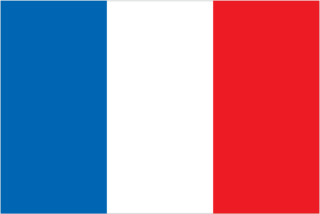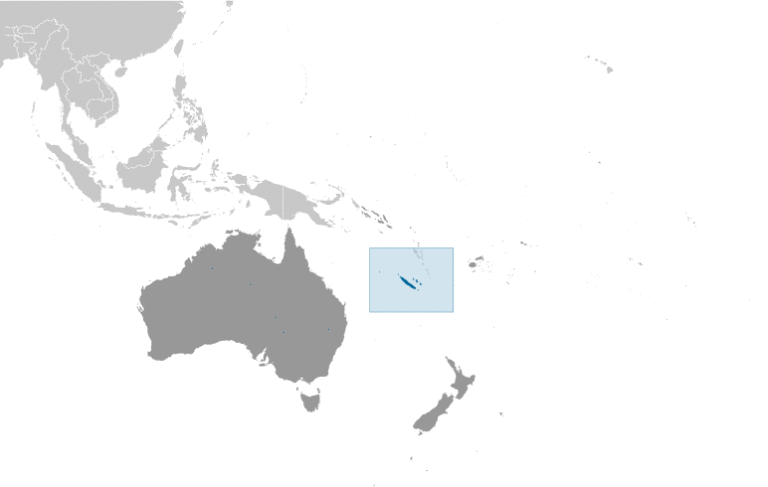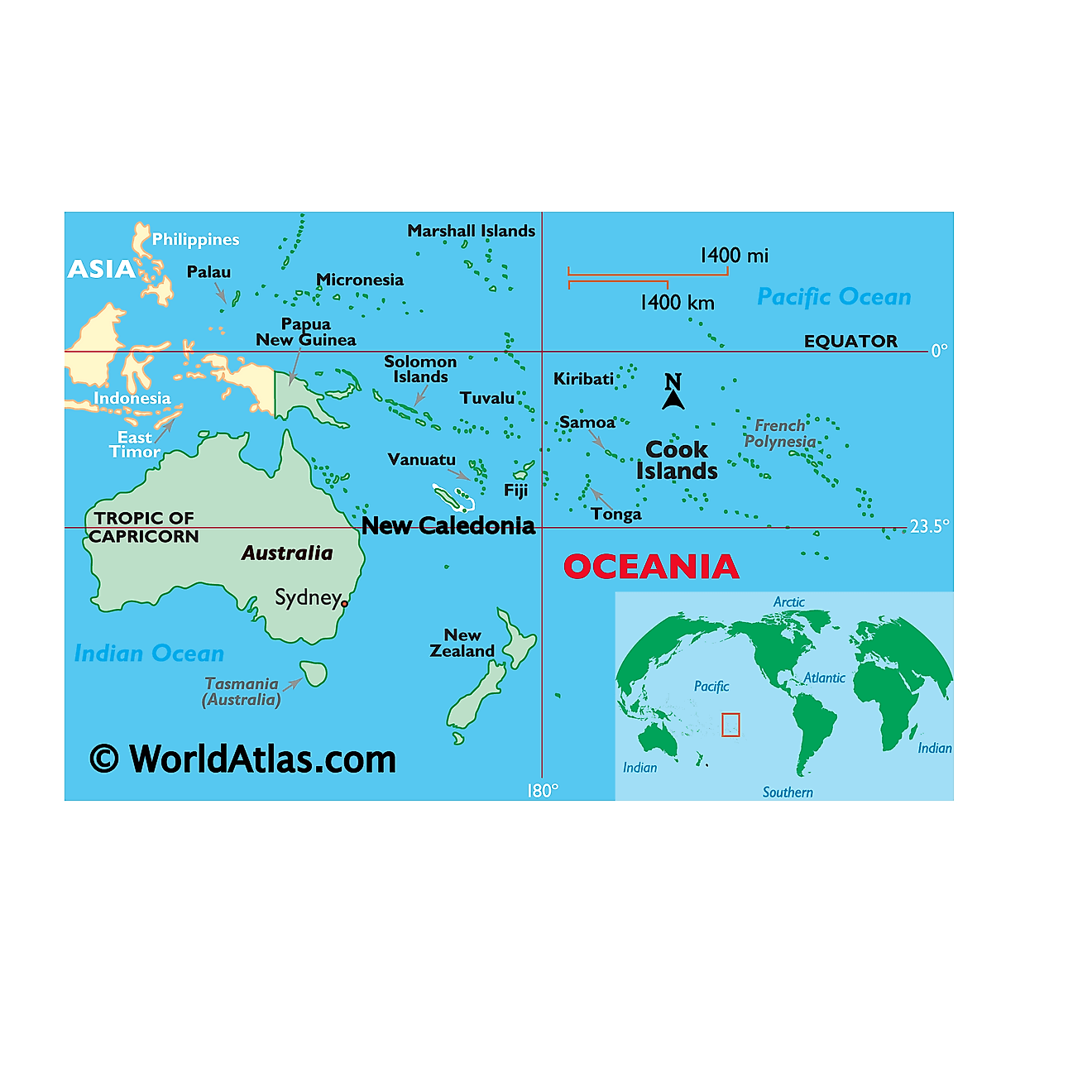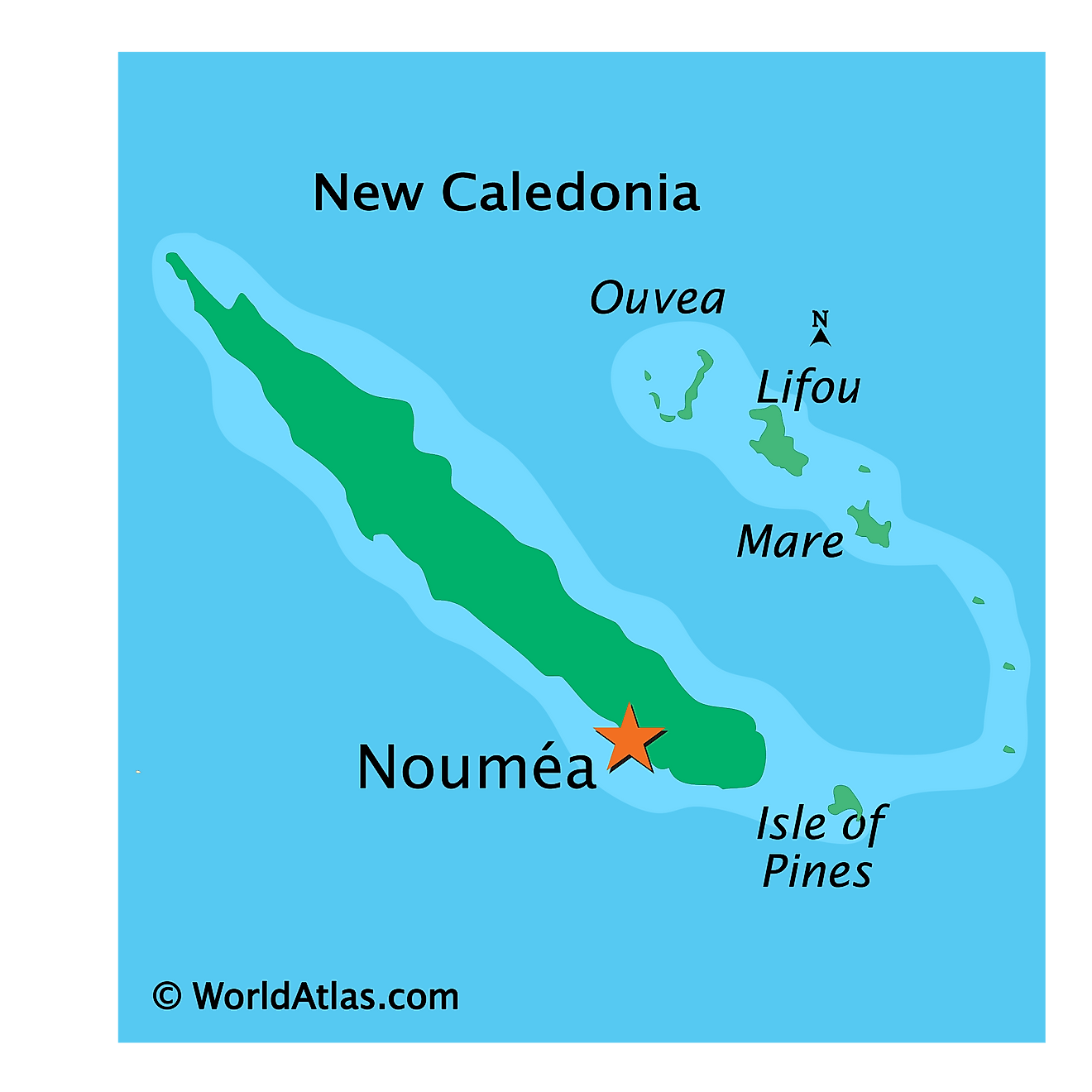The main island of New Caledonia– Grande Terre is cigar-shaped and has rugged mountain ranges running from north to south and rising at two high peaks. The island’s highest point is Mont Panié at an elevation of 1,628m is located in the northeast; while Mont Humboldt at an elevation of 1,618m is located in the southwest of the main island. The Central mountain range forms a natural boundary and separates the east coast from the west coast. The west coast of the island has savannah grasslands while the east coast has dense green vegetation. A ribbon of barrier reef encircles the entire Main Island. This 1,600 km long barrier reef is the world’s 2nd longest and shelters a lagoon having an area of 24,000 sq.km. Numerous small streams flow from the central mountain chain to the lagoon. The Diahot River is the longest river in the island. The three main islands – Ouvéa, Lifou and Maré together make up the Loyalty Islands, which occupy more than one-tenth of the total land area of New Caledonia and are raised coral plateaus.
Explore this New Caledonia map and discover the amazing geography of this island nation. Learn about the settlements, roads, highways, seaports, bays, capes, islands, points, and airports that make up the beautiful landscape of New Caledonia. See satellite imagery of Grand Terre and its other islands, and find out more about this stunning destination.
Online Interactive Political Map
Click on ![]() to view map in "full screen" mode.
to view map in "full screen" mode.
New Caledonia is divided into 3 provinces and 33 communes (municipalities). The provinces are: Province lles (Loyalty Islands Province), Province Nord (North Province) and Province Sud (South Province). The North and South Provinces are a part of the mainland of New Caledonia whereas the Loyalty Islands consists of a series of islands situated off the mainland.
Covering a land area of 18,576 sq.km, New Caledonia is a special collectivity of France, in the southwestern Pacific Ocean. The archipelago comprises of Grande Terre – the principal island, the Loyalty Islands, the Isle of Pines, the Chesterfield Islands, the Belep archipelago and numerous small, sparsely populated islands and atolls.
Located on a peninsula in the southwestern corner of Grande Terre (main island of New Caledonia) is, Nouméa – the capital and the largest city of the island territory. Nouméa is situated on an excellent protected deep-water harbor and hence serves as the chief seaport of New Caledonia. It is also the seat of the regional organization – The Secretariat of the Pacific Community.
Location Maps
Where is New Caledonia?
New Caledonia is a French overseas territory located in the Pacific Ocean. It consists of its main island, Grand Terre, which is home to the capital city of Nouméa. Other islands in the territory include the Loyalty Islands, the Chesterfield Islands, the Belep archipelago, and the Isle of Pines.
New Caledonia is part of the Melanesia region, south of Vanuatu and east of Australia, making it the closest French Pacific neighbor. The territory is divided into 3 provinces – The North and South Provinces on Grande Terre, as well as the Loyalty Islands Province. Major communities in New Caledonia include Nouméa, Le Mont-Dore, Dumbéa, and Païta.
High Definition Political Map of New Caledonia
History
New Caledonia was part of the continent Zealandia, which broke off from the supercontinent Gondwana between 79 million and 83 million years ago. The earliest traces of human presence in New Caledonia date back to the period when the Lapita culture was influential in large parts of the Pacific, c. 1600–500 BCE or 1300–200 BCE. The Lapita were highly skilled navigators and agriculturists. The first settlements were concentrated around the coast and date back to the period between c. 1100 BCE to 200 CE.
British explorer James Cook was the first European to sight New Caledonia, on 4 September 1774, during his second voyage. He named it “New Caledonia”, as the northeast of the island reminded him of Scotland. The west coast of Grande Terre was approached by the Comte de Lapérouse in 1788, shortly before his disappearance, and the Loyalty Islands were first visited between 1793 and 1796 when Mare, Lifou, Tiga, and Ouvea were mapped by English whaler William Raven. Raven encountered the island, then named Britania, and today known as Maré (Loyalty Is.), in November 1793. From 1796 until 1840, only a few sporadic contacts with the archipelago were recorded. About 50 American whalers left record of being in the region (Grande Terre, Loyalty Is., Walpole and Hunter) between 1793 and 1887. Contacts with visiting ships became more frequent after 1840, because of their interest in sandalwood.
As trade in sandalwood declined, it was replaced by a new business enterprise, “blackbirding”, a euphemism for taking Melanesian or Western Pacific Islanders from New Caledonia, the Loyalty Islands, New Hebrides, New Guinea, and the Solomon Islands into slavery, indentured or forced labour in the sugarcane plantations in Fiji and Queensland by various methods of trickery and deception. Blackbirding was practised by both French and Australian traders, but in New Caledonia’s case, the trade in the early decades of the twentieth century involved kidnapping children from the Loyalty Islands to the Grand Terre for forced labour in plantation agriculture. New Caledonia’s primary experience with blackbirding revolved around a trade from the New Hebrides (now Vanuatu) to the Grand Terre for labour in plantation agriculture, mines, as well as guards over convicts and in some public works. In the early years of the trade, coercion was used to lure Melanesian islanders onto ships. In later years indenture systems were developed; however, when it came to the French slave trade, which took place between its Melanesian colonies of the New Hebrides and New Caledonia, very few regulations were implemented. This represented a departure from contemporary developments in Australia, since increased regulations were developed to mitigate the abuses of blackbirding and ‘recruitment’ strategies on the coastlines.
The first missionaries from the London Missionary Society and the Marist Brothers arrived in the 1840s. In 1849, the crew of the American ship Cutter was killed and eaten by the Pouma clan. Cannibalism was widespread throughout New Caledonia.
French colonisation
On 24 September 1853, under orders from Emperor Napoleon III, Admiral Febvrier Despointes took formal possession of New Caledonia. Captain Louis-Marie-François Tardy de Montravel founded Port-de-France (Nouméa) on 25 June 1854. A few dozen free settlers settled on the west coast in the following years. New Caledonia became a penal colony in 1864, and from the 1860s until the end of the transportations in 1897, France sent about 22,000 criminals and political prisoners to New Caledonia. The Bulletin de la Société générale des prisons for 1888 indicates that 10,428 convicts, including 2,329 freed ones, were on the island as of 1 May 1888, by far the largest number of convicts detained in French overseas penitentiaries. The convicts included many Communards, arrested after the failed Paris Commune of 1871, including Henri de Rochefort and Louise Michel. Between 1873 and 1876, 4,200 political prisoners were “relegated” to New Caledonia. Only 40 of them settled in the colony; the rest returned to France after being granted amnesty in 1879 and 1880.
In 1864, nickel was discovered on the banks of the Diahot River; with the establishment of the Société Le Nickel in 1876, mining began in earnest. To work the mines the French imported labourers from neighbouring islands and from the New Hebrides, and later from Japan, the Dutch East Indies, and French Indochina. The French government also attempted to encourage European immigration, without much success.
The indigenous Kanak people were excluded from the French economy and from mining work, and ultimately confined to reservations. This sparked a violent reaction in 1878, when High Chief Ataï of La Foa managed to unite many of the central tribes and launched a guerrilla war that killed 200 Frenchmen and 1,000 Kanaks. A second uprising [fr] occurred in 1917, with Protestant missionaries like Maurice Leenhardt functioning as witnesses to the events of this war. Leenhardt would pen a number of ethnographic works on the Kanak of New Caledonia. Noël of Tiamou led the 1917 rebellion, which resulted in a number of orphaned children, one of whom was taken into the care of Protestant missionary Alphonse Rouel. This child, Wenceslas Thi, would become the father of Jean-Marie Tjibaou (1936–1989).
Europeans brought new diseases such as smallpox and measles, which caused the deaths of many natives. The Kanak population declined from around 60,000 in 1878 to 27,100 in 1921, and their numbers did not increase again until the 1930s.
In June 1940, after the fall of France, the Conseil Général of New Caledonia voted unanimously to support the Free French government, and in September the pro-Vichy governor was forced to leave for Indochina.
In 1941, some 300 men from the territory volunteered for service overseas. They were joined, in April, by 300 men from French Polynesia (‘the Tahitians’), plus a handful from the French districts of the New Hebrides: together they formed the Bataillon du Pacifique (BP). The Caledonians formed two of the companies, and the Polynesians the other two. In May 1941, they sailed to Australia and boarded the RMS Queen Elizabeth for the onward voyage to Africa. They joined the other Free French (FF) battalions in Qastina in August, before moving to the Western Desert with the 1st FF Brigade (1re BFL). There they were one of the four battalions who took part in the breakout after the Battle of Bir Hakeim in 1942. Their losses could not easily be replaced from the Pacific and they were therefore amalgamated with the Frenchmen of another battalion wearing the anchor of ‘la Coloniale’, the BIM, to form the: Bataillon de l’infanterie de marine et du Pacifique (BIMP). The combined battalion formed part of the Gaulliste 1re Division Motorisée d’Infanterie/Division de Marche d’Infanterie (DMI), alongside three divisions from the French North African forces, in the French Expeditionary Corps (CEF) during the Italian Campaign. They landed in Provence in 1944, when they were posted out and replaced by local French volunteers and résistants.
Meanwhile, in March 1942, with the assistance of Australia, New Caledonia became an important Allied base, and the main South Pacific Fleet base of the United States Navy in the South Pacific moved to Nouméa in 1942–1943. The fleet that turned back the Japanese Navy in the Battle of the Coral Sea in May 1942 was based at Nouméa. American troops stationed on New Caledonia numbered as many as 50,000, matching the entire local population at the time.
French overseas territory
In 1946, New Caledonia became an overseas territory. By 1953, French citizenship had been granted to all New Caledonians, regardless of ethnicity.
During the late 1940s and early 1950s, New Caledonia strengthened its economic links with Australia, particularly as turmoil within France and its empire weakened New Caledonia’s traditional economic links to metropolitan France; New Caledonia supplied nickel to Australia in exchange for coal vital for smelting nickel. New Caledonian exports of iron ore and timber to Australia also increased during this time period.
The European and Polynesian populations gradually increased in the years leading to the nickel boom of 1969–1972, and the indigenous Kanak Melanesians became a minority, though they were still the largest ethnic group.
Between 1976 and 1988, conflicts between French government actions and the Kanak independence movement saw periods of serious violence and disorder. In 1983, a statute of “enlarged autonomy” for the territory proposed a five-year transition period and a referendum in 1989. In March 1984, the Front Indépendantiste, a Kanak resistance group, seized farms and the Kanak and Socialist National Liberation Front (FLNKS) formed a provisional government. In January 1985, the French Socialist government offered sovereignty to the Kanaks and legal protection for European settlers. The plan faltered as violence escalated. The government declared a state of emergency; however, regional elections went ahead, and the FLNKS won control of three out of four provinces. The centre-right government elected in France in March 1986 began eroding the arrangements established under the Socialists, redistributing lands mostly without consideration of native land claims, resulting in over two-thirds going to Europeans and less than a third to the Kanaks. By the end of 1987, roadblocks, gun battles and the destruction of property culminated in the Ouvéa cave hostage taking, a dramatic hostage crisis on the eve of the presidential elections in France. Pro-independence militants on Ouvéa killed four gendarmes and took 27 hostage. The military assaulted the cave to rescue the hostages. Nineteen Kanak hostage takers were killed and another three died in custody, while two soldiers were killed during the assault.
The Matignon Agreements, signed on 26 June 1988, ensured a decade of stability. The Nouméa Accord, signed 5 May 1998, set the groundwork for a 20-year transition that gradually transfers competences to the local government.
In 2008, six lagoons of the New Caledonian barrier reef, the world’s longest continuous barrier reef system, were inscribed on the UNESCO World Heritage List.
Following the timeline set by the Nouméa Accord that stated a vote must take place by the end of 2018, the groundwork was laid for a referendum on full independence from France at a meeting chaired by the French Prime Minister Édouard Philippe on 2 November 2017, to be held by November 2018. Voter list eligibility was the subject of a long dispute, but the details were resolved in an electoral list that granted automatic eligibility to voters of Kanak origin but excluded those of other origins who had not been longtime residents of the territory. The referendum was held on 4 November 2018, with independence being rejected.
Another referendum was held in October 2020, with voters once again choosing to remain a part of France. In the 2018 referendum, 56.7% of voters chose to remain in France. In the 2020 referendum, this percentage dropped with 53.4% of voters choosing to remain part of France.
The third referendum was held on 12 December 2021. The referendum was boycotted by pro-independence forces, who argued for a delayed vote due to the impact caused by the COVID-19 pandemic; when the French government declined to do so, they called for a boycott. This led to 96% of voters choosing to stay with France.
Physical Map of New Caledonia
Geography
New Caledonia is part of Zealandia, a fragment of the ancient Gondwana super-continent. It is speculated that New Caledonia separated from Australia roughly 66 million years ago, subsequently drifting in a north-easterly direction, reaching its present position about 50 million years ago.
The mainland is divided in length by a central mountain range whose highest peaks are Mont Panié (1,629 m or 5,344 ft) in the north and Mont Humboldt (1,618 m or 5,308 ft) in the southeast. The east coast is covered by a lush vegetation. The west coast, with its large savannahs and plains suitable for farming, is a drier area. Many ore-rich massifs are found along this coast.
The Diahot River is the longest river of New Caledonia, flowing for some 100 kilometres (62 mi). It has a catchment area of 620 km (240 sq mi) and opens north-westward into the Baie d’Harcourt, flowing towards the northern point of the island along the western escarpment of the Mount Panié. Most of the island is covered by wet evergreen forests, while savannahs dominate the lower elevations. The New Caledonian lagoon, with a total area of 24,000 square kilometres (9,300 sq mi) is one of the largest lagoons in the world. The lagoon and the surrounding New Caledonia Barrier Reef was named a UNESCO World Heritage Site in 2008 for its exceptional beauty and marine biodiversity.
Climate
The climate is tropical, with a hot and humid season from November to March with temperatures between 27 °C and 30 °C, and a cooler, dry season from June to August with temperatures between 20 °C and 23 °C, linked by two short interstices. The tropical climate is strongly moderated by the oceanic influence and the trade winds that attenuate humidity, which can be close to 80%. The average annual temperature is 23 °C, with historical extremes of 2.3 °C and 39.1 °C.
The rainfall records show that precipitation differs greatly within the island. The 3,000 millimetres (120 in) of rainfall recorded in Galarino are three times the average of the west coast. There are also dry periods, because of the effects of El Niño. Between December and April, tropical depressions and cyclones can cause winds to exceed a speed of 100 kilometres per hour (62 mph), with gusts of 250 kilometres per hour (160 mph) and very abundant rainfall. The last cyclone affecting New Caledonia was Cyclone Niran, in March 2021.







